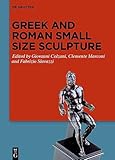Greek and Roman Small Size Sculpture / ed. by Fabrizio Slavazzi, Giovanni Colzani, Clemente Marconi.
Material type: TextPublisher: Berlin ; Boston : De Gruyter, [2023]Copyright date: ©2023Description: 1 online resource (VI, 294 p.)Content type:
TextPublisher: Berlin ; Boston : De Gruyter, [2023]Copyright date: ©2023Description: 1 online resource (VI, 294 p.)Content type: - 9783110740790
- 9783110741865
- 9783110741742
- 733
- online - DeGruyter
- Issued also in print.
| Item type | Current library | Call number | URL | Status | Notes | Barcode | |
|---|---|---|---|---|---|---|---|
 eBook
eBook
|
Biblioteca "Angelicum" Pont. Univ. S.Tommaso d'Aquino Nuvola online | online - DeGruyter (Browse shelf(Opens below)) | Online access | Not for loan (Accesso limitato) | Accesso per gli utenti autorizzati / Access for authorized users | (dgr)9783110741742 |
Frontmatter -- Contents -- Small-Scale Sculpture in Greek and Roman Society: A Reassessment -- Sizing up Art: The Intermedial Semantics of Scale in the Hellenistic and Roman Worlds -- Small Is Beautiful: The Aesthetic Approach to Small-Scale Sculptures in Ancient Criticism -- Small-scale Cult Statues of the Sixth Century BC -- Small Statements of Prestige: On a Group of Early Classical Marble Statuettes from Selinunte -- From Mold to Masterpiece: Producing Small- Scale Hellenistic Ruler Bronzes in Ptolemaic Egypt -- A Miniature Myth: About Some Clay Figurines of the Niobids -- Alexander Riders: Small-Scale Portraits of Alexander the Great on Horseback -- Parvitatis ut miraculum: Pliny the Elder and Nature’s Sense of Scale -- Scripta effigies: un esempio di interazione testo-immagine in Marziale e in Stazio -- Una statua di Eracle al Museo Nazionale Romano: fra scultura ideale e ritratto -- Lavorare in scala: derivazioni e metamorfosi dell’Atena Parthenos -- Il mito nell’arredo di lusso. Modalità di adattamento di soggetti a tutto tondo nei monopodi marmorei romani -- Index
restricted access online access with authorization star
http://purl.org/coar/access_right/c_16ec
Considerations about size and scale have always played a central role within Greek and Roman visual culture, deeply affecting sculptural production. Both Greeks and Romans, in particular, had a clear notion of “colossality” and were able to fully exploit its implications with sculpture in many different areas of social, cultural and religious life. Instead, despite their ubiquitous presence, an equal and contrary categorization for small size statues does not seem to have existed in Greek and Roman culture, leading one to wonder what were the ancient ways of conceptualizing sculptural representations in a format markedly smaller than “life-size.” Even in the context of modern scholarship on Classical Art, few notions appear to be as elusive as that of “small sculpture”, often treated with a certain degree of diffidence well summarized in the formula Klein, aber Kunst? In fact, a large and heterogeneous variety of objects corresponds to this definition: all kinds of small sculpture, from statuettes to miniatures, in a variety of materials including stone, bronze, and terracotta, associated with a great array of functions and contexts, and with extremely different levels of manufacture and patronage. It would be a major misunderstanding to think of these small sculptures in general as nothing more than a cheap and simplified alternative to larger scale statues. Compared with those, their peculiar format allowed for a wider range of choices, in terms, for example, of use of either cheap or extremely valuable materials (not only marble and bronze, but also gold and silver, ivory, hard stones, among others), methods of production (combining seriality and variation), modes of fruition (such as involving a degree of intimacy with the beholder, rather than staging an illusion of “presence”). Furthermore, their pervasive presence in both private and public spaces at many levels of Greek and Roman society presents us with a privileged point of view on the visual literacy of a large and varied public. Although very different in many respects, small-sized sculptures entertained often a rather ambivalent relationship with their larger counterparts, drawing from them at the same time schemes, forms and iconographies. By offering a fresh, new analysis of archaeological evidence and literary sources, through a variety of disciplinary approaches, this volume helps to illuminate this rather complex dynamic and aims to contribute to a better understanding of the status of Greek and Roman small size sculpture within the general development of ancient art.
Issued also in print.
Mode of access: Internet via World Wide Web.
In English.
Description based on online resource; title from PDF title page (publisher's Web site, viewed 06. Mrz 2024)


